208 Search Results for core boards
May 30, 2013
by Carole Zangari -
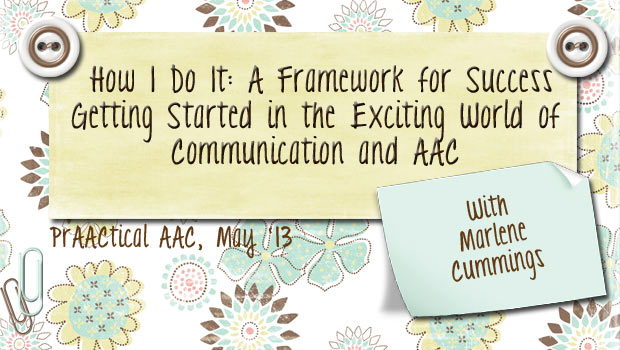
We couldn’t be more excited to have a return visit from Marlene Cummings, a wonderful SLP who is currently serving as an AAC Consultant to the AAC Team at Oakland Schools. In her first post, Marlene talked about strategies for cultivating the right mindset for AAC teaching. In this post, Marlene continues sharing elements of her Framework for Success in discussing the Knowledge Toolbox, developed with the Oakland Schools AAC Team. 5 Things in Your “Knowledge Toolbox” What is already in my “knowledge toolbox” of communication, language and learning? Yes, you do have a full toolbox. You just don’t realize it. And of course there are always new and exciting things to add. You already know this stuff!! REMEMBER??? It is important to step back and think broadly about communication and what it really does. Sometimes we get caught in the details of our work and can’t see the forest through the... [Read More...]
May 28, 2013
by Robin Parker -
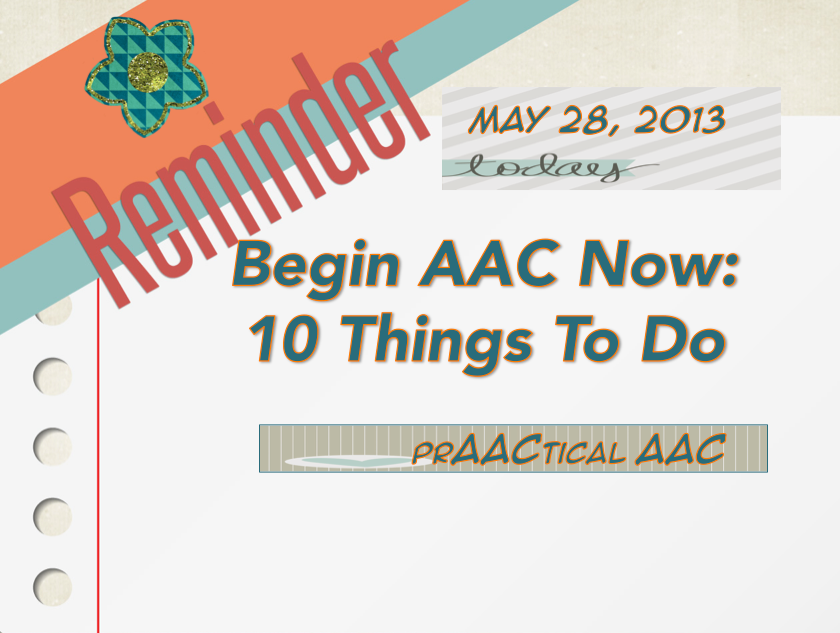
If you know someone with significant speech difficulties, BEGIN AAC NOW…. If you know someone, try something… Doing something, even if it isn’t perfect, is infinitely better than doing nothing at all…. There is no specific order for these suggestions, try what is appropriate and doable for you… A year from now you may wish you started today (K. Lamb)… So begin now at any level.. for someone, a class, a clinic, for a few… Create a Visual Language & AAC Environment: Visual Immersion Program, Meaningful Language Experiences, Importance of Using Visual Supports Speak AAC to the AAC Learner: Use Aided Language Input (ALI), Learning to Use ALI Get Assessment Information: Communication Matrix , AAC Evaluation Genie, Thoughts & Ideas, AAC Assessment Forms, Write & Implement Some AAC Goals: Goals That Matter, AAC in the IEP by Lauren Enders, PrAActical Goals Learn and Use a Core Word Approach: Core Word Communication Board Samples, About Core Words- First... [Read More...]
May 18, 2013
by Carole Zangari -
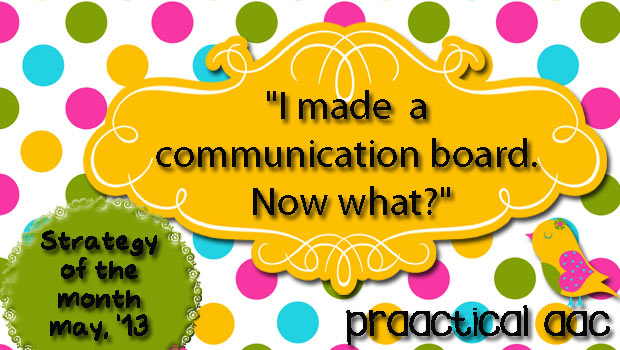
Earlier this month, we shared some ideas for making communication boards using color coding and also for creating boards geared to different communicative purposes. Making the communication board according to some basic principles is a good thing, of course, and it takes a decent amount of thought and planning. Even more important, though, is developing an intervention plan so that the augmentative communicator learns how to use the board effectively. Here are some of our thoughts on how to teach someone to use a new communication board. Model It We’ve talked about aided language input so many times that I’m almost embarrassed to mention it. Almost. The truth is, it is a ‘must do’ strategy when we’re first introducing a communication board, book, SGD, or AAC app. Incidental learning is important for just about all of the people with whom we work. It is never the only strategy we use,... [Read More...]
May 7, 2013
by Carole Zangari -
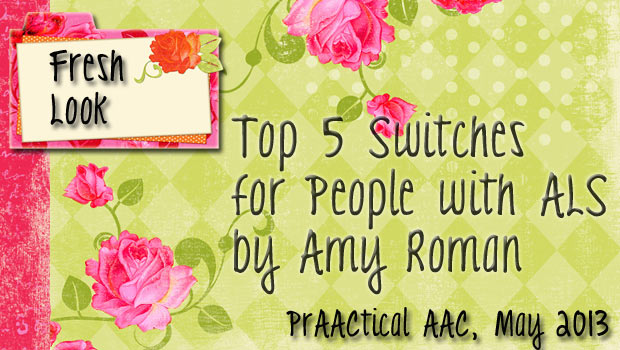
We continue our celebration of Better Hearing and Speech Month (#BHSM) with our Fresh Look series. In this post, we are delighted to share the insights of SLP Amy Roman, whose expertise in AAC supports for people with ALS is well-known. During the past 13 years, Amy has been a member of the multidisciplinary care team at San Francisco’s Forbes Norris ALS Research and Treatment Center. The AAC Program she developed at the Norris Center was awarded Program of the Year by the California Speech and Hearing Association in 2010. Through her private practice, she also provides AAC direct services and phone/skype consultations to individuals, caregivers and therapists. In addition, Amy is the Director of the Golden West ALS Association’s AAC Lending Library. She is also the author of AlphaCore© communication software available on DynaVox speech generating devices. Amy has presents workshops and at conferences on clinical and research topics in AAC.... [Read More...]
April 25, 2013
by Carole Zangari -
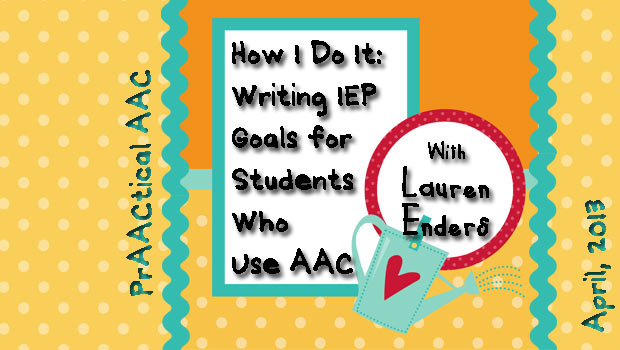
We’re so happy to welcome Lauren Enders back to share some more thoughts on AAC and the IEP. In her first post on this topic, Lauren addressed some frequently asked questions. Today, she provides a very valuable perspective on writing IEP goals for students who use or need AAC and some wonderful resources. Very often, I receive requests for support from teachers and speech therapists that are writing IEP goals for their students who use AAC. When we sit down to discuss their questions, the first thing I remind them is that AAC goals are no different from any other IEP goal. I recall a workshop I attended years ago presented by Gail VanTatenhove that helps put IEP goals for AAC into perspective. Gail said that AAC therapy is just language therapy. Isn’t that true? Aren’t we just teaching language? For this student, language is simply being expressed in a... [Read More...]
April 1, 2013
by Robin Parker -
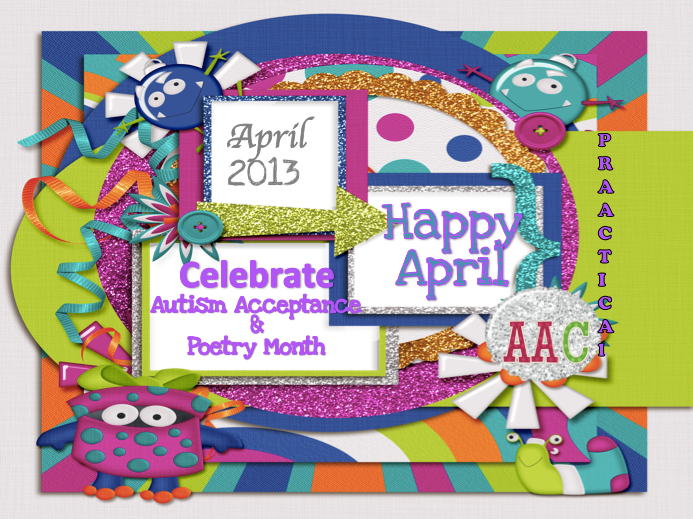
There are a lot of celebrations this month. It is officially Autism Awareness Month. A new name for this that has popped up & taken hold is Autism Acceptance Month. Awareness and/or Acceptance seems to mean different things to different people but hopefully the intent is similar. We hope that this month is filled with great ideas to support ALL people with autism and their families. We hope that educators, clinicians, and whole communities are inclusive, that they presume competence, and that they support communication and language using best prAACtice information and research. We do know that there is more to hope for than just this, like better employment outcomes, more appropriate accommodations, and more individualized support but if focus stays on the former, it seems then that the latter would improve. Plus we have more control (if there is such a thing) on facilitating inclusivity, presuming competence, and of course... [Read More...]
March 26, 2013
by Robin Parker -
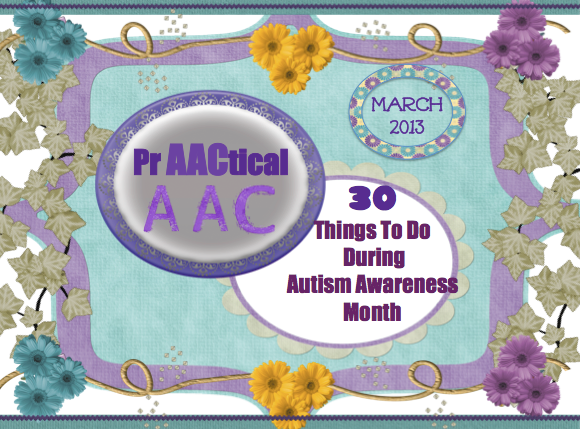
We love getting EVERYONE involved in Autism Awareness/Acceptance Month. We like to take a goal focused approach to our autism activities by choosing projects that facilitate autism awareness & acceptance, positive attitudes, and autism & communication learning. We pass out materials, have contests, go to events, do extra talks, and try and engage EVERYONE we know and even some we do not know. We do a lot of shopping (with small amount of money, but we have to EAT and accessorize). Our families, pets, friends, and students all participate. It is a month filled with purposeful fun. Here are some of the things we will be doing. Please share any activities or projects that you know about. Read & share 5 references that support the use of AAC & Autism (evidence based research) Check out the Online Autistic Carnival which is currently accepting submission of various video documentaries (music, art, writing,... [Read More...]
March 2, 2013
by Carole Zangari -
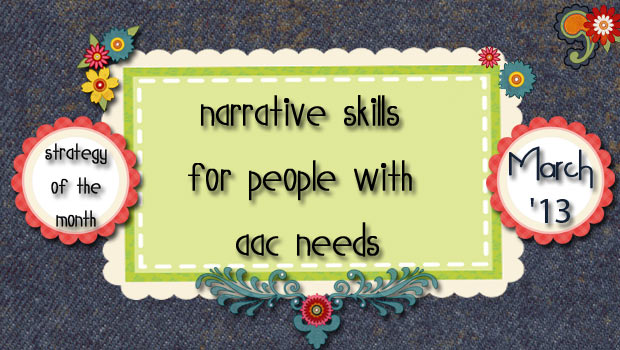
This month, we’ll share some thoughts about helping people with AAC needs develop narrative skills. Why narrative skills? Because they help us connect to one another and communication learning works best when we feel connected. Among other things, storytelling helps us relate to one another. Narrative language is important for reading and writing skills to develop. It helps us understand the world and ourselves. In telling our stories, we establish our identities. Plus, it’s part of what makes life fun. In the US, pediatric therapists are having lots of conversations about the Common Core State Standards (CCSS) in English Language Arts (ELA), and how they relate to the IEP goals of the students that they serve. Many of the goals in the ELA speaking domain require students to be able to summarize what they hear and read, so it is no surprise that SLPs are prioritizing narrative language and related... [Read More...]
January 31, 2013
by Carole Zangari -
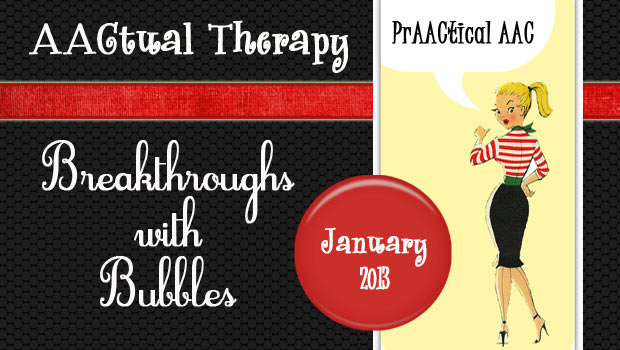
We couldn’t be happier that one of our first AACtual Therapists is Tanna Neufeld, a south Floridian on loan to the Pacific Northwest. Tanna was with us as a graduate student many years ago, and went on to build a fantastic reputation in our community for her excellent clinical skills. It was South Florida’s loss when she left last year and moved across the continent. (I know at least a few people scheming of ways to get her back.) Tanna is now working at the Children’s Therapy Center in Seattle. Tanna blogs at SNEAK Outside the Box and My Blind Side. You can read more about her at the end of this post, in which Tanna talks about using bubbles in her AAC therapy sessions. AAC Breakthroughs with Bubbles! When I first started using core vocabulary boards with my kids, I didn’t really know where to start. It was really... [Read More...]
January 26, 2013
by Carole Zangari -
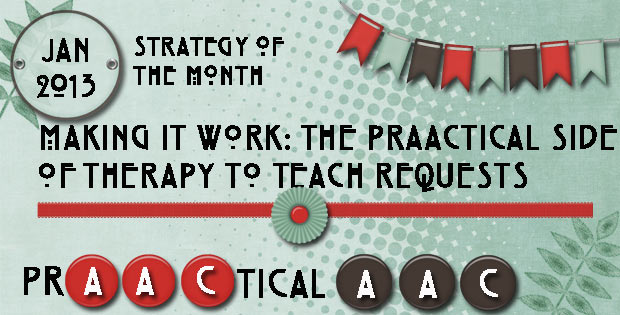
This month we’ve been talking about requesting and choicemaking, specifically how to teach it. Today, we’ll put it into a clinical context by talking about a hypothetical session that targets this skill, but also highlights other strategies. As you read about the materials, preparation, and script, look for how they incorporate strategies such as building specific communication opportunities {CO}, aided language input {ALI}, and expansions {EX}. The clinician also builds in repetition with variety so that there is sufficient opportunities for teaching and practice using multiple modes of communication. In this scenario, you’ll meet Jenna, a 5 year old with significant language difficulties secondary to Cri du Chat syndrome. Jenna’s communication system includes about a dozen manual signs (SIGN), 20-25 word approximations (SPEECH), a few gestures (GEST), some manual communication boards (COMM BD), and an iPad with a full-featured AAC app (iPAD). She also uses movement (MOVEMT), vocalizations (VOC), and... [Read More...]









